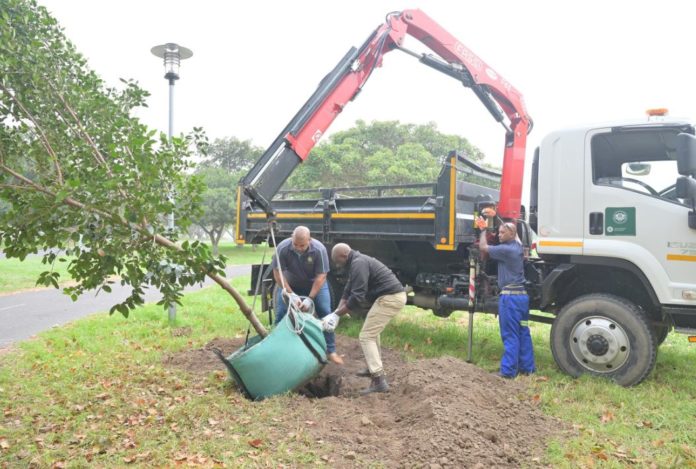The City of Cape Town has called on residents to participate in a voluntary tree replacement initiative as they remove beetle infested trees from public owned land.
Eddie Andrews, the City’s Deputy Mayor and Mayoral Committee Member for Spatial Planning and Environment, planted the first replacement tree – an Assegai tree, or Curtisia Dentana – a locally indigenous species, along the Liesbeek River in Mowbray last week.
Officials are busy removing trees along that route that are infested with the Polyphagous Shot Hole Borer beetle (PSHB).
Andrews explains the Assegai tree is a good replacement choice:
”The Assegai tree is a locally indigenous tree, occurring in the kloof forests on the Peninsula and therefore, well adapted and suitable to Cape Town’s climate. Also, as far as we know, the Curtisia Dentana is not a reproductive host tree, meaning, to date, the PSHB has not been sighted in these trees.”
The Assegai is a small to medium, very neat, evergreen tree that usually grows to a maximum of 12 meters. They are fast growing and do very well when sheltered from strong winds. They produce attractive yellow fruits that are relished by birds.
The City is working on a comprehensive list of recommended trees – indigenous and mostly locally indigenous, and not known to be prone to PSHB infestations – that residents can plant to replace those trees we will have to remove because of the beetle pest.
At the moment, the following trees are recommended:
- Assegai tree (Curtisia Dentana)
- White milkwood (Sideroxylon inerme) – a well-known, large tree that does well in coastal sands
- Camphor bush (Tarchonanthus camphoratus) – very tough, small multi-branched tree, that does well on the Cape Flats
- Water pear (Syzigium quineense) – a medium to large classic park type tree
The City started removing infested trees along the Liesbeek River corridor, near the N2 highway and Liesbeek Park Way, with chainsaws and wood chipping machines on Wednesday, 8 March 2023.
The beetle infested biomass is being transported to an appropriate site for incineration.
Latest update about the beetle pest:
- By 9 March 2023 the City recorded 191 infested trees, 104 on City-owned land and 87 on private properties in the southern suburbs.
- Most infested and affected trees in the Southern suburbs are Boxelder, London Plane, English Oak and Grey Poplar.
- Areas affected are Newlands, Kenilworth, Mowbray, Rondebosch, Observatory and Wynberg.
- Currently, priority is given to the removal of Boxelders from City-owned land along major transport routes.
Do’s and don’ts:
- Do not move any plant or tree material from areas with confirmed cases of PSHB, such as Somerset West, Newlands, Kenilworth, Mowbray, Rondebosch, Observatory and Wynberg.
- When handling plant material, inspect the tree for PSHB symptoms
- Clean gardening and other tools before and after use and disinfect vehicles used to transport green waste
- Transport green waste in closed and sealed bags, or cover the back with a sail cover
- Avoid routes passing through areas with PSHB infested trees
- Buy firewood where you are going to use it
- Don’t fall for fake remedies. There is no known cure as yet
What to look out for and symptoms of infested trees:
- Branch dieback – cracks on the branch; discoloured leaves; dry and leafless branches; branch break-off revealing webs of galleries filled with black fungus
- Gumming – blobs of goo coming out of the bark; oozing of liquid and gum from the beetle holes
- Entry and exit holes – very small holes on the bark of the tree, the size of a sesame seed (2mm); shotgun-like scars developing around the holes
- Staining – brown or dark stains on the bark of the tree
- Important: infested trees must be chipped on site and may not be removed from the property as the removal of the chipped wood will spread the pest to other areas.
How to report PSHB beetle sightings
- Online, at www.capetown.gov.za/InvasiveSpecies
- Call the City of Cape Town’s Invasive Species Unit on 021 444 2357, Monday to Friday, from 07:30 to 16:00
- Send an email to: invasive.species@capetown.gov.za
What to do with infested trees:
- Chip the tree, place the infested material in refuse bags, seal it and put these in direct sunlight for at least six weeks
- Dump the chips in your compost heap as the heat build-up will kill the beetle
- Burn infected wood at appropriate incineration facilities
- Seek assistance from trained and equipped service providers with sound knowledge of PSHB
- Do not move plant/tree material/firewood outside of areas where PSHB has been confirmed to be present to other areas
- Do not transport any form of green waste in open vehicles, cover it with sail covers even if no PSHB has been identified as such green waste.
- Clean tools and equipment used to trim/cut/prune plants
- The City will try its best to respond within 10 working days to verify a reported sighting.


